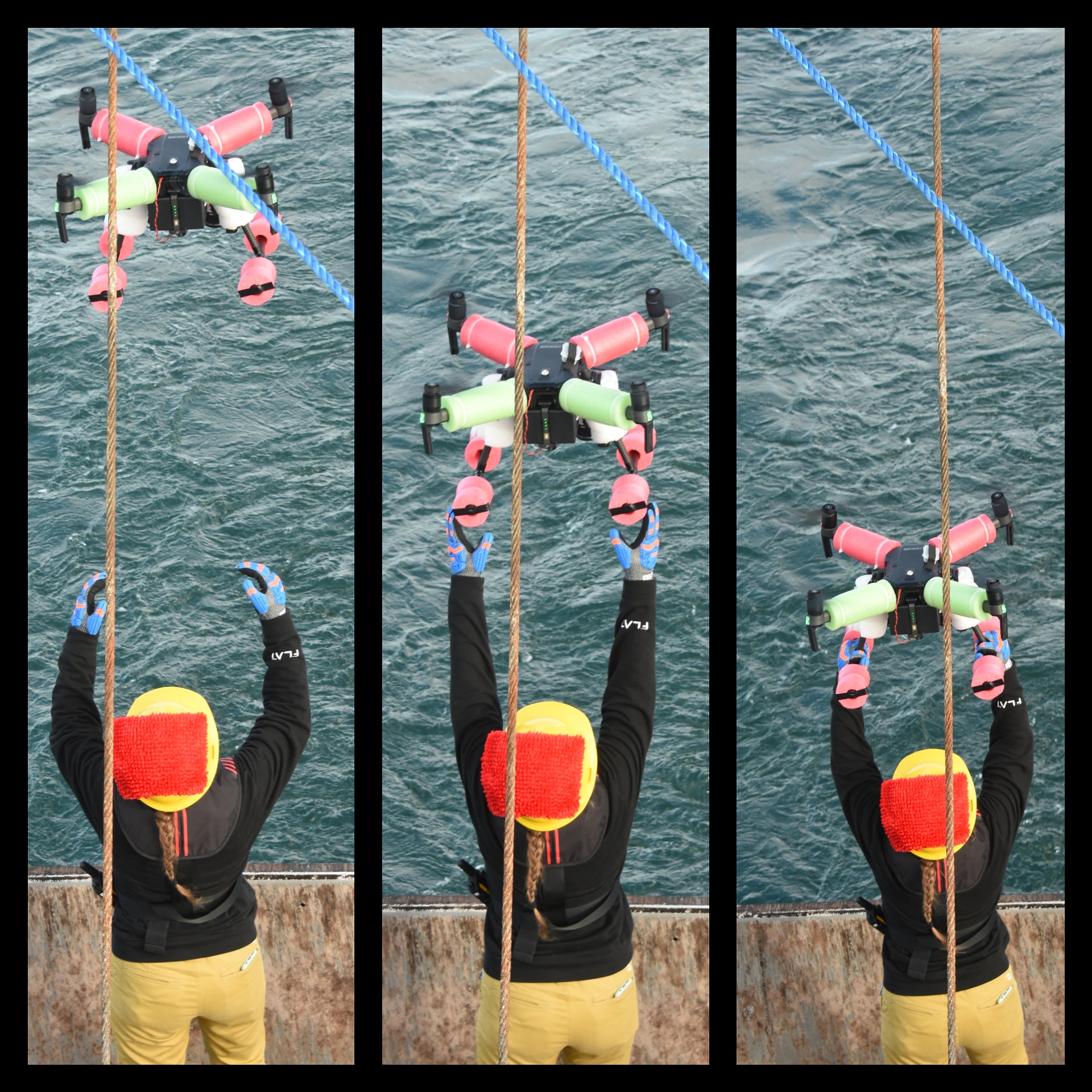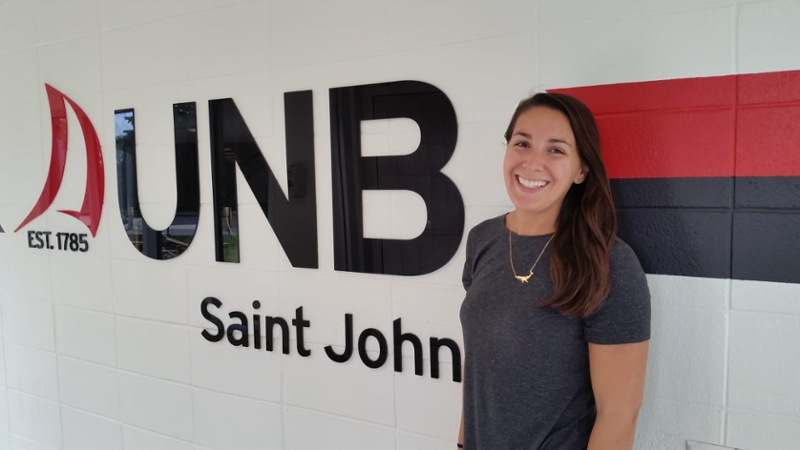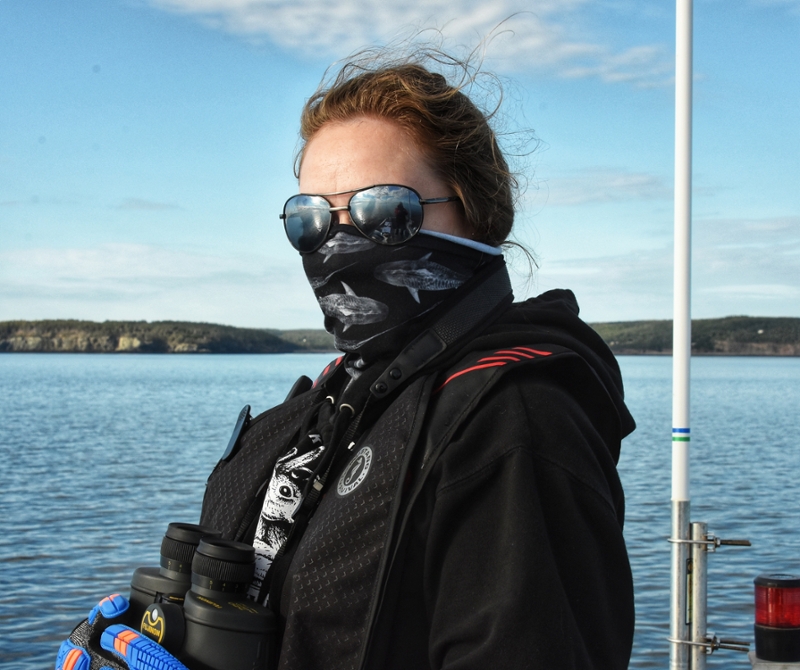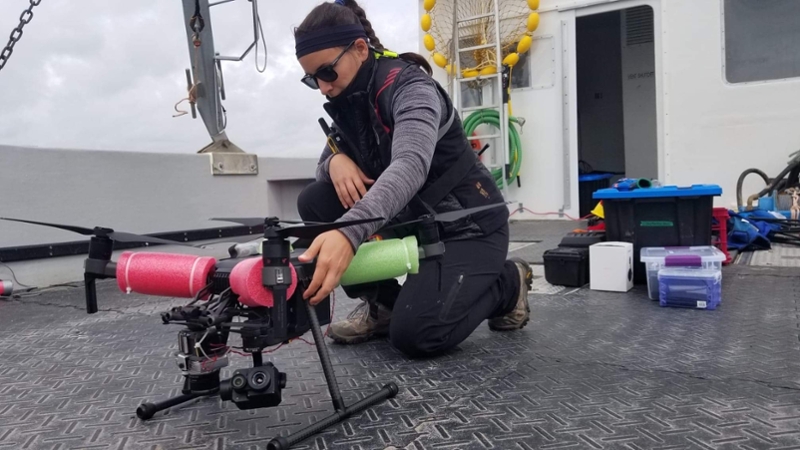A whale of a tale: UNB researchers explore new ways of measuring whale health
Author: UNB Research
Posted on Dec 2, 2020
Category: Research

Image: UNB is here… in the Bay of Fundy: UNB researchers captured this photo of two humpback whales in the Bay of Fundy during a research trip in 2020.
Graduate student Gina Lonati followed whales to UNB’s Saint John campus; now, she’s following them with drones to better understand the relationship between body temperature and health.
“While attending a conference in Halifax in 2017, I became aware of just how desperate the North Atlantic right whale situation is – there are only 350 left, and the situation is not improving,” said Ms. Lonati. “I was drawn to UNB in 2019, when an opening in Dr. Davies' lab gave me an opportunity to become involved in the mission to protect right whales. Dr. Davies' students and colleagues are informing real-world management decisions about whales in Atlantic Canada, and it's an honor to be a part of this diverse team that is dedicated to making a difference.”
This summer, she embarked on a month-long fieldwork trip in the Bay of Fundy, working with supervisor Dr. Kimberley Davies, assistant professor in biological sciences; Natasha Hynes, whale laboratory technician in biological sciences; and “Matty,” a drone equipped with stable hovering capabilities and multiple cameras.
The team collected data for Ms. Lonati’s project, using Matty’s thermal camera to measure a whale’s blowhole temperature when they take a breath. They also collected environmental data to properly calibrate the thermal images. While they were unable to find right whales, the team was able to collect data on more than 20 other whales, including humpback whales, minke whales, and one fin whale.
“When we spot one (or more) whales, we launch the drone from the boat with the goal of positioning it over the surfacing whale(s),” said Ms. Lonati. “I start by taking full-colour photographs of the whales from an altitude of about 20 m. I then slowly descend to about 12 m over the whales to record thermal video of them taking a breath."
Natasha Hynes provided field practice and safety gear support to Ms. Lonati. At sea, she was also responsible for hand launching and catching the drone.

Ms. Hynes, like Ms. Lonati, sees importance and value in contributing to research that could help right whales:
“The great thing about working on this project is knowing the possible applications that can come from it,” she said. “To know that the methods being developed right now could be used as an important conservation tool for North Atlantic Right Whales is very rewarding, and I’m incredibly fortunate to be a part of it.”
The colour photos are used to measure the whales, particularly their length and width. The ratio between these two can provide insight about the whale’s overall body condition. The thermal video will allow Ms. Lonati to estimate the whale’s internal body temperature.
“Whales are well-insulated by their blubber, but when they open their blowholes to breathe, we can see a little deeper into their respiratory system,” said Ms. Lonati. “In a way, it's like using a contactless thermometer! Once we measure blowhole temperature from enough whales, my hope is that we will be able to detect when a whale is sick, based on it having a "fever," or perhaps even being colder than normal.”
The next step of Ms. Lonati’s project involves, as she emphasized, “lots and lots and lots” of data analysis and photograph and video review. In two weeks, the team had collected over 4,000 images and video clips; now, she’ll work to calibrate, collate, and interpret that information.
Meet the researchers:
Gina Lonati (she/her):
 I'm originally from New Jersey, USA. I have a B.A. in biology from Bowdoin College (Maine) and an M.Sc. in marine biology from the University of North Carolina Wilmington.
I'm originally from New Jersey, USA. I have a B.A. in biology from Bowdoin College (Maine) and an M.Sc. in marine biology from the University of North Carolina Wilmington.
From 2014 to 2019, I worked for the Florida Fish & Wildlife Conservation Commission as a stranding biologist, responding to injured, sick, entangled, orphaned or dead marine mammals along the western coast of Florida.
I started my PhD in January 2020. In April, I was honored to receive a Vanier Canada Graduate Scholarship, which provides generous funding support for the next three years of my PhD.
(Ms. Lonati's work on protecting the right whale was featured in Canadian Geographic; read the article online.)
Dr. Kimberley Davies (she/her):
 I’m an Assistant Professor at UNB here in Saint John. I received my BSc in biology from the University of Victoria and a PhD in Oceanography from Dalhousie University.
I’m an Assistant Professor at UNB here in Saint John. I received my BSc in biology from the University of Victoria and a PhD in Oceanography from Dalhousie University.
I began working on North Atlantic right whales in 2007 with the goal of improving our understanding of the environmental and biological processes affecting their habitat use in Canadian waters. I’m committed to engaging the public and policymakers on science-based decision-making and right whale issues.
In 2014, I co-created the Whales, Habitat and Listening Experiment, an 8-year collaborative research program co-funded by government, NGOs and industry that seeks to deepen our knowledge of the relationships of baleen whale and their habitats, and improve adaptive conservation management of right whales through real-time acoustic monitoring.
I’ve been recognized for my work in applied and fundamental research with awards including the Liber Ero Postdoctoral Fellowship in conservation research in 2015, followed by the Canadian National Committee for the Scientific Committee on Ocean Research Early Career Ocean Scientist Award in 2017.
(Did you know? One of Dr. Davies' other projects is an underwater acoustic glider, used to detect and protect whales. Read more about this success here!)
Natasha Hynes (she/her):
 I’m a Canadian marine biologist from the island of Newfoundland. In 2018, I completed my BSc at Dalhousie University in Halifax, Nova Scotia with a major in marine biology and a minor in French. Before coming to UNB, I worked as a taxonomic technician and trained and certified as a CAUS (Canadian Association of Underwater Science) Scientific Diver I.
I’m a Canadian marine biologist from the island of Newfoundland. In 2018, I completed my BSc at Dalhousie University in Halifax, Nova Scotia with a major in marine biology and a minor in French. Before coming to UNB, I worked as a taxonomic technician and trained and certified as a CAUS (Canadian Association of Underwater Science) Scientific Diver I.
I came to UNB in February 2020 to work in the Davies Lab in a dynamic lab technician role. A portion of my time is spent working with the Canadian Whale Institute on various projects, including a mariner outreach program and social media content creation. For the Davies Lab, I handle the day-to-day operations of the lab and office and assist with the lab’s research projects. No two days are alike!
“Matty”
(As “Matty” lacks the capacity to write, this bio was provided by Gina Lonati.)
 “Matty was manufactured in China by a company called DJI. She came to our lab in the spring of 2020 and fit in right away! She has several unique abilities that make her a huge asset to our team: (1) her ability hold multiple cameras/sensors at once (for example, a high-resolution RGB camera and a thermal camera); (2) she provides us with live-streaming video of what is below her via a remote controller; (3) she has a battery system that lasts >20 min; (4) she can maintain a very stable hovering altitude thanks to specialized GPS sensors; (5) she can be launched/caught from the deck of a boat; and (6) she has an obstacle avoidance system that makes flying her much easier and safer! So far, she has 30 hours of flight time and has seen our lab members, beaches, fields, forests, lighthouses, birds, seals, whales, and porpoises from a unique aerial perspective.”
“Matty was manufactured in China by a company called DJI. She came to our lab in the spring of 2020 and fit in right away! She has several unique abilities that make her a huge asset to our team: (1) her ability hold multiple cameras/sensors at once (for example, a high-resolution RGB camera and a thermal camera); (2) she provides us with live-streaming video of what is below her via a remote controller; (3) she has a battery system that lasts >20 min; (4) she can maintain a very stable hovering altitude thanks to specialized GPS sensors; (5) she can be launched/caught from the deck of a boat; and (6) she has an obstacle avoidance system that makes flying her much easier and safer! So far, she has 30 hours of flight time and has seen our lab members, beaches, fields, forests, lighthouses, birds, seals, whales, and porpoises from a unique aerial perspective.”
(Oh, and those pool noodles? They’re dual purpose: They act as a floatation device in case of a water landing, and the colours help orient the operator for which way Matty is facing!)
Interested in getting involved in research in this field?
Here’s Gina’s advice:
“Look for ways to get involved in research early, especially at the undergraduate level. Even if the work doesn't relate to marine mammals, getting solid experience with experimental design, data collection/management, statistical analyses, and scientific writing is a huge bonus later on. Don't be afraid to contact professors or people who have jobs that you want to have, and ask how they got there!”
More information:
Dr. Kimberley Davies | Department of Biological Sciences (Saint John) | Faculty of Science, Applied Science and Engineering (Saint John) | Research at UNB | Graduate Studies at UNB